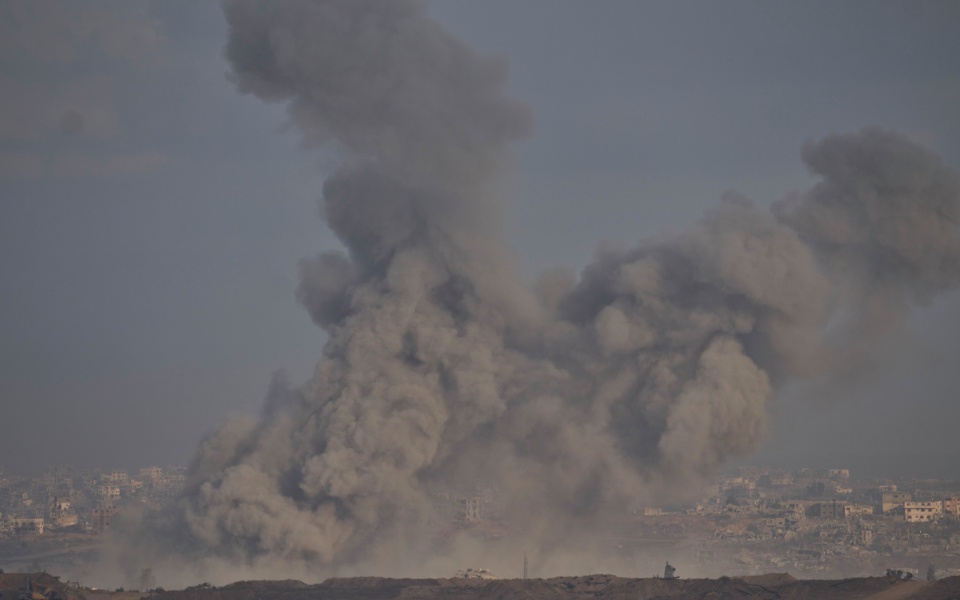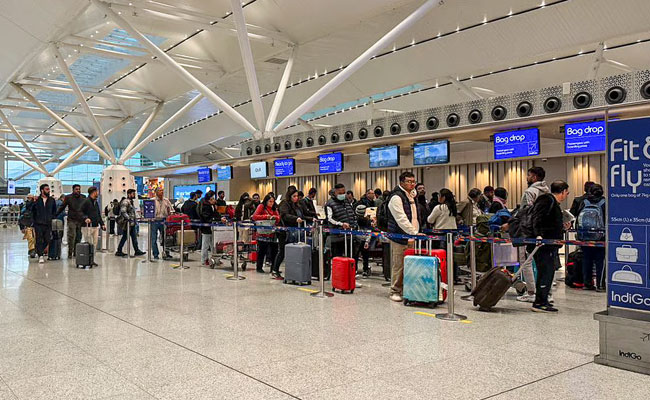Deir al-Balah, Jul 17 (AP): An Israeli shell slammed into the compound of the only Catholic church in the Gaza Strip on Thursday, killing three people and wounding 10 others, including the parish priest, according to church officials. The late Pope Francis, who died in April, had regularly spoken to the priest about the situation in the war-ravaged territory.
The shelling of the Holy Family Catholic Church in Gaza also damaged the church compound, where hundreds of Palestinians have been sheltering from the 21-month Israel-Hamas war. Israel issued a rare apology and said it was investigating.
Pope Leo XIV on Thursday renewed his call for an immediate ceasefire in response to the attack.
In a telegram of condolences for the victims, Leo expressed “his profound hope for dialogue, reconciliation and enduring peace in the region.” The pope said he was “deeply saddened to learn of the loss of life and injury caused by the military attack," and expressed his closeness to the wounded priest, Rev. Gabriel Romanelli, and the entire parish.
Hundreds of people sheltered at the church
The church compound was sheltering both Christians and Muslims, including a number of children with disabilities, according to Fadel Naem, acting director of Al-Ahli Hospital, which received the casualties.
The Catholic charity Caritas Jerusalem said the parish's 60-year-old janitor and an 84-year-old woman receiving psychosocial support inside a Caritas tent in the church compound were killed in the attack. Parish priest Romanelli was lightly wounded.
“We were struck in the church while all the people there were elders, innocent people and children,” said Shady Abu Dawood, whose mother was wounded by shrapnel to her head. “We love peace and call for it, and this is a brutal, unjustified action by the Israeli occupation.”
The Israeli military said it was investigating. It said it “makes every feasible effort to mitigate harm to civilians and civilian structures, including religious sites, and regrets any damage caused to them.”
In a rare move, the Israeli Foreign Ministry posted an apology on social media. “Israel expresses deep sorrow over the damage to the Holy Family Church in Gaza City and over any civilian casualty,” it said.
Israel has repeatedly struck schools, shelters, hospitals and other civilian buildings, accusing Hamas group of sheltering inside and blaming them for civilian deaths. Palestinians say nowhere has felt safe since Israel launched its offensive in response to Hamas' Oct. 7, 2023, attack.
Italian Premier Giorgia Meloni blamed Israel for the strike on the church. “The attacks on the civilian population that Israel has been demonstrating for months are unacceptable,” she said.
Church compounds have been struck before
The church is just a stone's throw from Al-Ahli Hospital, Naem said, noting that the area around both the church and the hospital has been repeatedly struck for over a week.
The Greek Orthodox Patriarchate of Jerusalem, which also has a church in Gaza that previously sustained damage from Israeli strikes, said the Holy Family Church was sheltering 600 displaced people, including many children, and 54 people with disabilities. It said the building suffered significant damage.
Targeting a holy site “is a blatant affront to human dignity and a grave violation of the sanctity of life and the inviolability of religious sites, which are meant to serve as safe havens during times of war,” the Church said in a statement.
Separately, another person was killed and 17 wounded Thursday in a strike against two schools sheltering displaced people in the Al-Bureij refugee camp in central Gaza, according to Al-Awda Hospital. The Israeli military did not immediately comment on the strike.
The Gaza Health Ministry said that over the past 24 hours, local hospitals received the bodies of 94 people killed in Israeli strikes and another 367 wounded.
Pope Francis spoke almost daily with Gaza church
In the last 18 months of his life, Francis would often call the lone Catholic church in the Gaza Strip to see how people huddled inside were coping with a devastating war.
Francis had repeatedly criticized Israel's wartime conduct, and last year suggested that allegations of genocide in Gaza — which Israel has rejected as a “blood libel” — should be investigated. The late pope also met with the families of Israeli hostages and called for their release.
Only 1,000 Christians live in Gaza, an overwhelmingly Muslim territory, according to the US State Department's international religious freedom report for 2024. Most are Greek Orthodox.
The Holy Land's Christian population has dwindled in recent decades as many have emigrated to escape war and conflict or to seek better opportunities abroad. Local Christian leaders have recently denounced attacks by Israeli settlers and Jewish extremists.
Ceasefire talks continue
There has been little visible progress in months of indirect talks between Israel and Hamas aimed at a new ceasefire and hostage release agreement, after Israel ended an earlier truce in March.
According to an Israeli official familiar with the details, Israel is showing “flexibility” on some of the issues that have challenged negotiators, including Israel's presence in some of the security corridors the military has carved into the territory.
The official, speaking on condition of anonymity because they were discussing ongoing negotiations, said Israel has shown some willingness to compromise on the Morag Corridor, which cuts across southern Gaza. However, other issues remain, including the list of Palestinian prisoners to be freed by Israel and commitments to end the war.
The official says there are signs of optimism but there won't be a deal immediately.
Hamas-led group killed some 1,200 people, mostly civilians, in the Oct. 7 attack and abducted 251 people, most of whom have since been released in ceasefire agreements or other deals. Fifty hostages are still being held, less than half of them believed to be alive
Israel's retaliatory offensive has killed over 58,600 Palestinians, according to Gaza's Health Ministry, which has said women and children make up more than half of the dead. It does not distinguish between civilians and fighters in its tally.
The ministry is part of the Hamas-run government but is led by medical professionals. The United Nations and other international organisations consider its figures to be the most reliable count of war casualties.
Let the Truth be known. If you read VB and like VB, please be a VB Supporter and Help us deliver the Truth to one and all.
New Delhi (PTI): The Supreme Court on Monday asked the Enforcement Directorate (ED) to file its response within three days on a bail plea of journalist Mahesh Langa in a money laundering case linked to an alleged financial fraud.
A bench comprising Chief Justice of India (CJI) Surya Kant and Justice Joymalya Bagchi also asked senior advocate Kapil Sibal, appearing for the jailed journalist, to file rejoinder, if needed, to the ED's response within two days of it being filed.
The top court fixed the case for further hearing on December 15.
During the brief hearing on Monday, Sibal said a journalist has been facing as many as six cases.
"The journalist is accused of extortion," the counsel for the ED said and sought a short adjournment on the ground that Solicitor General Tuhar Mehta was unavailable at the moment.
The top court on September 8 sought responses from the Gujarat government and the ED on Langa's bail plea.
While issuing the notices on Langa's bail plea, the bench asked, "What kind of a journalist is he?"
"With due respect, there are some very genuine journalists. But there are also people who on their scooter say we are 'patrakar' (journalists) and what they actually do everybody knows," the bench told Sibal.
Sibal replied that these are all allegations.
"In one FIR, he gets anticipatory bail, then a second FIR is lodged and again anticipatory bail is granted but now he is booked under a third FIR for income tax evasion. There are other things also against him," Sibal submitted.
He added that there is a background to the case also.
On July 31, the Gujarat High Court rejected Langa's bail plea in the money laundering case on the grounds that if released on bail, prejudice would be caused to the prosecution case.
On February 25, the ED said it arrested Langa in a money laundering investigation linked to an alleged financial fraud.
He was first arrested in October 2024 in a GST fraud case.
The money laundering case against Langa stems from two FIRs filed by Ahmedabad police on charges of fraud, criminal misappropriation, criminal breach of trust, cheating and causing wrongful loss of lakhs of rupees to certain people.





